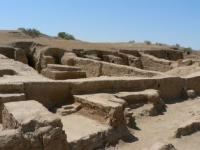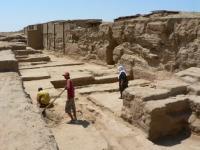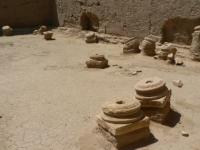Вы здесь
Karatepa Buddhist center.



Tours over architectural ensembles and complexes of the Surkhan-Darya area.
“The first law of history is to be afraid of any kind of lie, and then not to be afraid of any kind of truth.”
Cicero.
Sufi places in Termez.
Karatepa is one of the most famous sights in Termez. It is one of the most often attended sights during Uzbekistan tours. This is a Buddhist place of worship built on three hills situated in the north-west part of Old Termez.
Karatepa (II - IV century AD) Buddhist Cult Centre, facilities at the three hills in the north-west corner of the fort Old Termez. Is a series of interconnected temple-monastery complexes that have arisen at the beginning of II century AD Feature architecture karatepinskih complexes is the combination of cave-dwelling buildings cut into the Quaternary sediments of sandstone buildings and land from pakhsa and adobe bricks.
The interiors of the shrines were decorated with ornamental painting and story on stucco plaster and glinolessovaya sculpture. The architectural decoration of the widely used marble and carved limestone Ganj. In the Kushan period, according to the dedicatory inscriptions on ceramics Buddhist Centre in Karatepa (or part thereof) could be named Khadevakavihara - Royal Monastery.
In the II - III centuries, thanks to the support of the Kushan administration karatepinsky center reaches its peak. Later, in IV-V centuries, much of the systems stops functioning. At this time the caves were used for burials, and then input into them, usually pawned brick.
However, it is likely that along with these complexes, some all or part of their land continued to exist as budiyskie sanctuary until the VI century. In the IX-XII centuries poluzasypannye cave hermits settle - Sufis. The walls of caves karatepinskih saved numerous drawings of graffiti and inscriptions Visitor (Bactrian, srednepersidskie, Brahmi, Sogdian, Syria (?), Arabic), as appearing in the operating hours of the Buddhist center, and after its decline, when the entrance to the cave was still available.
It includes a number of temples and monasteries that appeared in the beginning of the IInd century A.D. It is a great historical monument you should visit during your Uzbekistan tour. The architecture of Karatepa is a combination of caves cut in quaternary sandstone, and surface buildings made of pahsa and unbaked brick.
Interiors of the shrines were decorated with topical and ornamental paintings on stucco plaster and sculptures made of loess and clay. If you go to the Uzbekistan tour you’ll know much more about this manufacturing.
And you’ll know about architectural decor of this place during Uzbekistan tour too. In this decor marble-like limestone and carved stucco were widely used. Visitors traveling around Uzbekistan can actually know that the Karatepa center achieved the peak of flourishing in the IInd - IIIrd centuries. And in IVth - Vth centuries a considerable part of the shrines stopped functioning.
However, it is highly probable that some shrines, or at least their surface parts continued to exist as Buddhist places of worship till the 6th century. It is unknown whether some Buddhist Monasteries were destroyed by the Arabs.
However, Arabs wanted to eradicate other religions on this territory, so they levied special dues on non-Moslim cult. This probably put an end to the function of Buddhist monuments in Termez and its surrounding area. Most likely, the monks living in the Buddhist monasteries of Termez moved to the region of Kashmir, where at that time the dynasty of the Karkots ruled and who were active supporters of Buddhism.
During your Uzbekistan tour, you’ll be told that VIII- IX centuries the majority of Tokharstan's population adopted the new religion that was brought by the Arabs. One of the causes of that non-Moslims had to pay huge taxes on territories. In the XIth - XIIth centuries hermits called “sufi” settled in semi-destroyed caves.
Walls of Karatepa caves still carry numerous graffiti drawings and visitor’s inscriptions (Bactrian, Middle Persian, Brahmi, Soghdian, Syrian, and Arabic) and it’ll be very interesting to look at them on Uzbekistan tour.
Besides, it probably will be interesting to know during Uzbekistan tour that both made when the Buddhist center was functioning and in the period of its decline when caves were still accessible.
Authority:
«The Guidebook on historical and cultural places of interest of the Surkhan-Darya area and the city of Termez». 2011.







